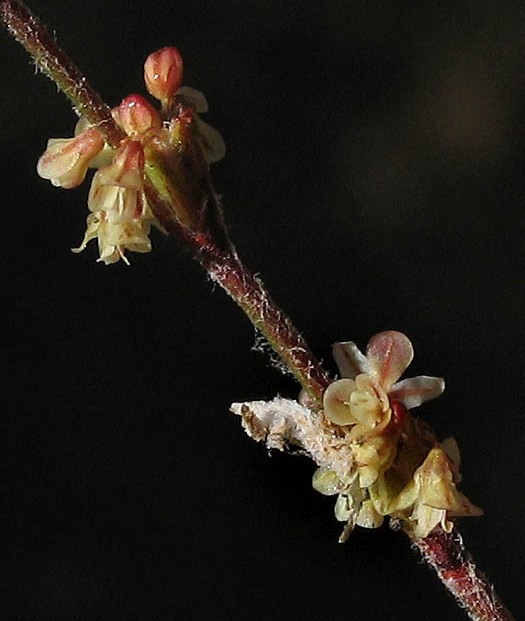Slender woolly buckwheat
(Eriogonum gracile)

Description
Eriogonum gracile is a species of wild buckwheat known by the common name slender woolly buckwheat. The annual plant is native to California, where it is widespread across the state except the deserts, and to parts of Baja California in northwestern Mexico. It grows in many types of habitat, including chaparral, montane, woodland, and grasslands. It is often found on clay soils, and also in sandy places. Eriogonum gracile is an annual herb which is quite variable in appearance. It grows erect to decumbent with a slender, branching stem 10 to 70 centimeters long, sometimes with a thick coat of woolly fibers and sometimes nearly hairless. The oblong leaves are borne on short petioles, the largest at the base of the plant with blades approaching 6 centimeters long. There are usually leaves along the lower part of the stem. The leaves are woolly in texture, at least on the undersides. The flowering stem is lined with small clusters of hairless flowers in shades of pink, yellow, or white. Eriogonum is a genus of flowering plants in the family Polygonaceae. The genus is found in North America and is known as wild buckwheat. This is a highly species-rich genus, and indications are that active speciation is continuing. It includes some common wildflowers such as the California buckwheat (Eriogonum fasciculatum). The genus derived its name from the Greek word erion meaning 'wool' and gonu meaning 'knee or joint'. The author of the genus, Michaux, explained the name as describing the first named species of the genus (E. tomentosum) as a wooly plant with sharply bent stems ("planta lanata, geniculata"). Despite sharing the common name "buckwheat", Eriogonum is part of a different genus than the cultivated European buckwheat and than other plant species also called wild buckwheat. It came into the news in 2005 when the Mount Diablo buckwheat (Eriogonum truncatum, believed to be extinct) was rediscovered. Eriogonum species are used as food plants by the larvae of some Lepidoptera (butterflies and moths). An example of a butterfly that uses this plant for food is the Lycaena heteronea. Several of these are monophagous, meaning their caterpillars only feed on this genus, sometimes just on a single taxon of Eriogonum. Wild buckwheat flowers are also an important source of food for these and other Lepidoptera. In some cases, the relationship is so close that Eriogonum and dependent Lepidoptera are in danger of coextinction.
Taxonomic tree:







